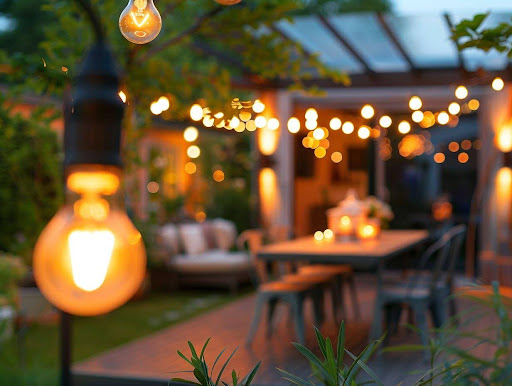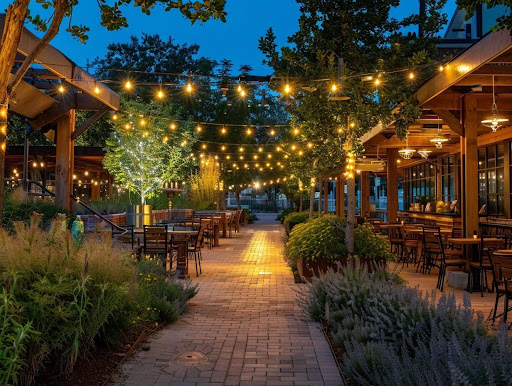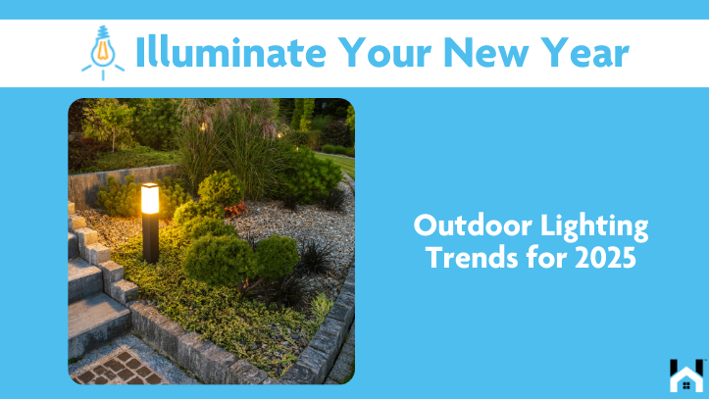If you are seeking to brighten your outdoor spaces while also saving money and benefiting the environment, your search ends here.
We delve into the significance of energy-efficient outdoor lighting and the advantages it brings for both the environment and your finances. Exploring options like solar-powered lights, LED alternatives, and motion sensor lights, we discuss the array of energy-efficient outdoor lighting choices available.
We offer guidance on important factors to weigh when selecting outdoor lighting, as well as tips on installation and usage to maximize efficiency. Uncover additional energy-conserving solutions, such as alternative power sources and timers/dimmers, to assist you in illuminating your outdoor areas in an environmentally friendly and cost-effective manner.
The Importance of Energy-Efficient Outdoor Lighting

Energy-efficient outdoor lighting is essential for creating sustainable and environmentally friendly spaces. Along with providing efficient lighting solutions for outdoor areas, it enhances the aesthetic appeal of landscapes, increases security, and promotes energy savings.
By incorporating energy-efficient outdoor lighting, both individuals and businesses can support environmentally friendly practices and decrease their carbon footprint. These eco-friendly solutions not only reduce light pollution but also help in preserving the natural habitat of wildlife.
Through strategic placement of LED lights, visibility and safety in outdoor spaces can be significantly improved, thus discouraging potential security threats. The utilization of smart lighting technologies further boosts energy conservation efforts by enabling remote monitoring and customization of lighting patterns to maximize efficiency.
Benefits for the Environment and Your Wallet
Opting for energy-efficient outdoor lighting not only benefits the environment by reducing energy consumption but also proves to be cost-effective in the long run. The sustainable nature of these lighting solutions offers both environmental advantages and financial savings.
Investing in energy-efficient outdoor lighting can yield significant returns on investment over time. By utilizing LED or solar-powered lights, property owners can notably lower their electricity bills while also reducing their carbon footprint. This transition to sustainable lighting options not only aids in decreasing greenhouse gas emissions but also assists in conserving energy resources for future generations. Furthermore, the robustness and longevity of energy-efficient outdoor lighting products result in reduced maintenance and replacement costs, thus further enhancing the economic advantages of these eco-friendly choices.
Types of Energy-Efficient Outdoor Lighting
Energy-efficient outdoor lighting solutions are available in various types, such as LED lights, solar-powered options, and motion sensor lights. These lighting alternatives provide bright illumination, weather-resistant characteristics, and increased security for outdoor areas.
LED lights are well-liked for their high levels of brightness and energy efficiency, making them well-suited for lighting up pathways and yards. Solar-powered lights make use of solar energy during the day and automatically illuminate at dusk, eliminating the need for wiring during installation. Motion sensor lights are fitted with sensors that detect movement, offering an additional security measure by alerting homeowners to potential intruders. These lighting choices address both the aesthetic and functional requirements of outdoor landscapes while heightening the safety and security of the surroundings.
Solar-Powered Lights
Solar-powered lights are a sustainable choice for outdoor lighting, as they harness energy from the sun to provide illumination. These energy-efficient options offer brightness, weatherproof construction, and a long lifespan, making them an ideal solution for eco-conscious outdoor lighting needs.
Their sustainable nature helps to reduce the carbon footprint associated with traditional lighting sources, making them environmentally friendly. Solar-powered lights are engineered to produce bright light levels, ensuring optimal visibility in outdoor spaces. Their weatherproof construction allows them to withstand various elements, from rain to snow, ensuring consistent performance regardless of the conditions. With their long-lasting performance, these lights require minimal maintenance, making them a convenient and cost-effective choice for outdoor lighting solutions.
LED Lights
LED lights are widely recognized for their energy-efficient characteristics and powerful brightness, making them a popular choice for outdoor lighting solutions. These lights deliver substantial energy savings and boast a lengthy lifespan, ensuring both durability and effectiveness.
The advanced LED technology not only offers a high degree of brightness that improves visibility in outdoor areas but also consumes less energy, thereby lowering electricity expenses. Due to the prolonged lifespan of LED lights, they necessitate less frequent replacement when compared to conventional lighting sources, resulting in long-term cost reductions and decreased maintenance requirements. This energy efficiency not only proves advantageous for individuals seeking to reduce their utility bills but also makes a positive contribution to environmental sustainability by curbing carbon emissions arising from electricity consumption.
Motion Sensor Lights

Motion sensor lights offer a practical and energy-efficient solution for outdoor lighting, activating only when motion is detected to improve security and effectiveness. These lights reduce energy usage by lighting up specific areas based on movement.
By employing motion detection technology, these lights can significantly decrease energy wastage in comparison to traditional outdoor lighting alternatives. The capability to switch on only when motion is detected not only enhances security by providing immediate illumination when necessary but also optimizes energy efficiency. This attribute is especially beneficial for locations where lighting requirements are sporadic, as the lights remain off until motion triggers them, thereby conserving energy and reducing electricity costs. The lowered power consumption of motion sensor lights contributes to a more sustainable and environmentally-friendly outdoor lighting solution.
Factors to Consider When Choosing Energy-Efficient Outdoor Lighting
When you're in the market for energy-efficient outdoor lighting, it's important to consider several key factors. Think about where the lighting will be placed and its intended purpose, the cost, maintenance requirements, and overall efficiency of the lighting solutions. Proper installation is critical to make the most out of energy-efficient outdoor lighting.
The location of outdoor lighting significantly impacts how well it serves its purpose. Whether it's in a garden, pathway, or patio, you want to ensure it meets your needs effectively. Regarding cost-effectiveness, LED lights are a popular choice for their long lifespan and energy efficiency. Don't forget to factor in maintenance needs – some lighting options require more upkeep than others. Efficiency levels also vary among different types of outdoor lighting, so selecting the right one can result in significant energy savings and improved illumination. And remember, correct installation is key to ensuring optimal performance and longevity of your outdoor lighting system.
Location and Purpose
The selection of energy-efficient outdoor lighting solutions is heavily influenced by the location and intended use of the lighting. Whether the purpose is security, aesthetics, or functionality, the right lighting design and placement are crucial for maximizing efficiency and effectiveness.
When determining the most suitable lighting solutions, it is important to take into account various factors such as the outdoor area's natural elements, potential obstructions, and the specific tasks or ambiance that need to be created. By customizing lighting solutions based on these considerations, one can not only save energy but also enhance the overall appeal and usability of the space.
Optimally placed outdoor lighting that effectively illuminates key areas while minimizing waste and glare improves its functionality and contributes to creating a sustainable and welcoming environment for both residents and visitors.
Cost and Maintenance
The selection of energy-efficient outdoor lighting is influenced by cost and maintenance considerations. Opting for cost-effective options that demand minimal maintenance is key to achieving long-term savings and ensuring smooth operation. Investing in low-maintenance lighting solutions can yield a substantial return on investment (ROI) over an extended period.
When individuals and businesses choose outdoor lighting solutions that are both energy-efficient and cost-effective, they can achieve significant cost reductions in the long term. Keeping maintenance needs minimal can further boost overall savings and operational efficiency. Emphasizing low-maintenance alternatives helps in preventing frequent replacements and repairs, ultimately saving time and money. The importance of selecting sustainable lighting that requires minimal upkeep cannot be overstated, as it guarantees a dependable and long-lasting lighting solution for various outdoor environments.
Installation and Usage Tips for Maximum Efficiency
Efficient installation and strategic use are essential for maximizing the effectiveness of energy-efficient outdoor lighting. Proper placement and maintenance practices, along with smart usage techniques to conserve energy, play a pivotal role in optimizing the performance of outdoor lighting solutions.
When considering outdoor lighting, it is crucial to choose the appropriate fixtures that meet your specific needs. Pathway lights, floodlights, and wall-mounted fixtures each have distinct functions and should be carefully positioned to provide optimal illumination.
Regularly examining and cleaning outdoor lighting fixtures can prevent the accumulation of dirt and ensure their proper operation. By incorporating timers, motion sensors, or smart lighting controls, you can further improve energy efficiency by activating lights only when necessary, thereby reducing unnecessary energy consumption.
Proper Placement and Maintenance

Proper placement and regular maintenance are crucial factors in ensuring that energy-efficient outdoor lighting remains effective and durable. When selecting outdoor lighting solutions, it is important to take into account the prevailing weather conditions. Opting for weatherproof lighting fixtures with long lifespans can help minimize maintenance requirements while maximizing performance.
Weather conditions have a significant impact on the efficiency and durability of outdoor lighting systems. By choosing weatherproof solutions that include sealed fixtures and resilient materials, individuals can shield the lights from adverse weather elements such as rain, snow, and extreme temperatures. These weatherproof options not only decrease the frequency of maintenance tasks but also enhance the overall lifespan of the lighting system, ensuring consistent performance over an extended period of time.
Smart Usage to Save Energy
Using intelligent technology features such as timers and dimmers can significantly aid in conserving energy through energy-efficient outdoor lighting. These smart tools can be harnessed for effective energy management by adjusting brightness levels and usage patterns to maximize energy savings.
By utilizing timers, individuals can set schedules for when outdoor lights should be turned on and off, thereby reducing unnecessary energy consumption during daylight hours. Dimmers offer flexibility in tweaking the brightness of lights, enabling the creation of the desired ambiance while utilizing only the required amount of energy. With these functionalities, users can tailor lighting settings according to their preferences and requirements, resulting in a more sustainable and cost-effective outdoor lighting solution.
Other Energy-Saving Solutions for Outdoor Lighting
Along with conventional choices, alternative power sources, timers, and dimmers offer energy-efficient solutions for outdoor lighting requirements. These innovative approaches help maximize energy efficiency, lower electricity expenses, and enhance the environmental sustainability of outdoor lighting systems.
Alternative power sources, such as solar panels, utilize solar energy to operate outdoor lights, decreasing reliance on traditional electricity sources. Timers can be programmed to automatically switch off lights during daylight hours or late at night, contributing to energy conservation. Dimmers offer the adaptability to adjust light brightness as necessary, preventing unnecessary energy usage. By incorporating these techniques, outdoor lighting can be made more sustainable, economical, and environmentally conscious.
Alternative Power Sources
Considering alternative power sources such as solar energy is a sustainable approach for energy-efficient outdoor lighting. Embracing solar energy for outdoor lighting can significantly reduce individuals' reliance on traditional electricity grids, leading to cost savings on energy bills. Solar-powered lighting solutions are low maintenance, as they do not require extensive wiring or frequent bulb replacements, making them hassle-free and convenient for property owners. Additionally, the use of solar energy helps in reducing greenhouse gas emissions, contributing to a healthier environment and cleaner air for all. This transition to solar power aligns with sustainable lighting practices and represents an eco-friendly innovation in the realm of outdoor lighting design.
Timers and Dimmers
The use of timers and dimmers in outdoor lighting systems presents programmable and energy-efficient options. These intelligent devices allow users to manage lighting settings, regulate brightness levels, and optimize energy consumption, thereby promoting energy conservation and effective lighting practices.
By integrating timers, individuals can set schedules for their outdoor lights to activate and deactivate at specific times, enhancing security and convenience, particularly when they are away from home. Dimmers offer the versatility to create various moods and atmospheres by adjusting the brightness of lighting fixtures. This not only enhances the visual appeal of outdoor spaces but also provides improved visibility without causing excessive glare.
Through the utilization of these advanced features, users can experience the advantages of energy-efficient lighting while maintaining a balance between style and functionality.
Frequently Asked Questions

What are energy-efficient outdoor lighting solutions?
Energy-efficient outdoor lighting solutions are lighting options that use minimal energy consumption while still providing adequate lighting for outdoor spaces. These solutions often utilize LED technology, solar power, or timers/sensors to reduce energy usage and provide cost savings for users.
What are the benefits of using energy-efficient outdoor lighting solutions?
There are several benefits to using energy-efficient outdoor lighting solutions. These include cost savings on energy bills, reduced environmental impact, longer lifespan of lighting fixtures, and improved safety and security for outdoor spaces.
How do LED lights contribute to energy efficiency in outdoor lighting?
LED lights are highly energy-efficient as they use up to 80% less energy than traditional incandescent bulbs. They also have a longer lifespan, reducing the need for frequent replacements and further reducing energy consumption. Additionally, LED lights produce less heat, making them a safer choice for outdoor lighting.
Can solar-powered outdoor lighting be effective in all climates?
Solar-powered outdoor lighting can be effective in all climates, as long as they receive adequate sunlight during the day to charge the batteries. However, in areas with low sunlight or frequent cloudy days, solar-powered lighting may not be as reliable and may require additional charging methods.
Are there any government or utility incentives for using energy-efficient outdoor lighting solutions?
Yes, there are often government or utility incentives available for using energy-efficient outdoor lighting solutions. These can include rebates, tax credits, or grants for switching to energy-efficient options. It is best to check with your local government or utility provider to see what incentives may be available in your area.
How can timers and sensors help with energy efficiency in outdoor lighting?
Timers and sensors can help with energy efficiency in outdoor lighting by automatically turning off lights when they are not needed, such as during daylight hours or when no one is in the area. This prevents unnecessary energy usage and can also extend the lifespan of the lighting fixtures.




